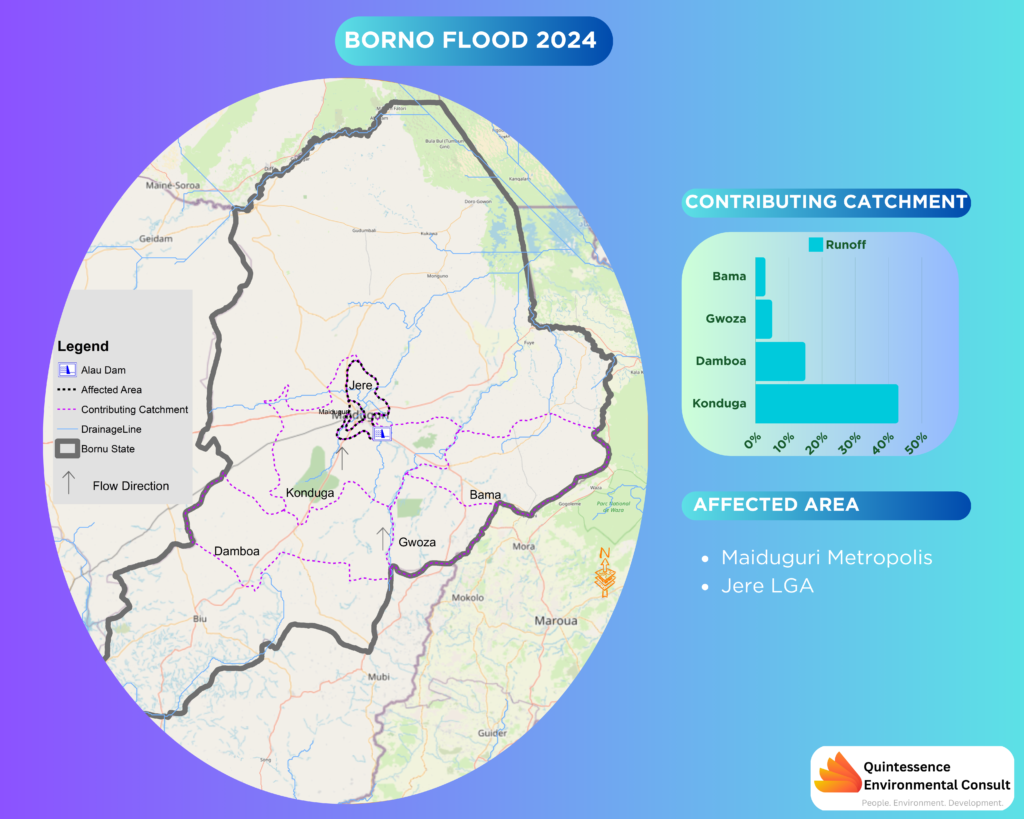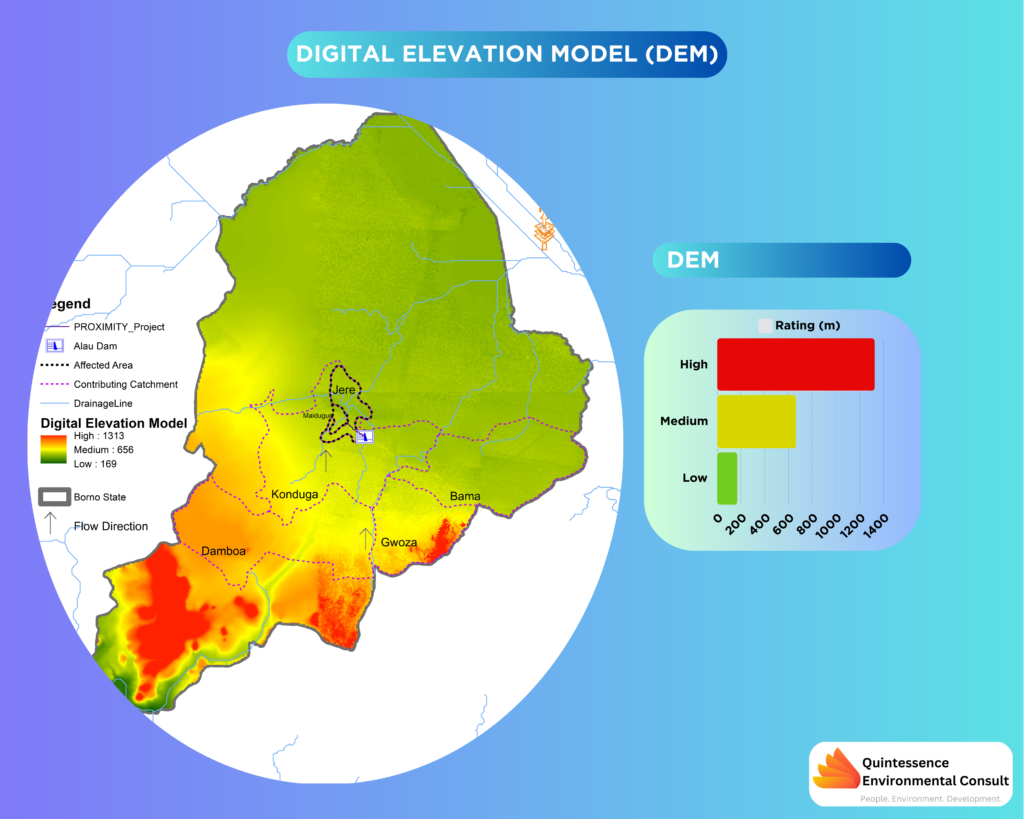
Location
Maiduguri Metropolitan Council, Jere and Konduga, Borno State, Nigeria
Incident Date
Tuesday, September 10, 2024
Background
Nearly a week after the flood incident in Borno State which flooded Maiduguri and its environs, the magnitude of devastation has left observers and experts alike in awe. Relevant emergency and humanitarian agencies have been overwhelmed due to limited logistical support to evacuate and relocate victims. So far, over 300,000 temporarily displaced people have been registered in 30 relocation sites.
Primary Cause of Flood
Collapse of the Alau Dam on the Ngadda River due to torrential rainfalls in the region and increased runoff was established to be the primary cause of the flood, making it the worst in 30 years. The last flood that occurred under similar conditions happened in 1994.
General Impact
- Death Toll: 37 confirmed deaths so far, and countless unaccounted for with the number expected to rise.
- Affected Population: Over 1.5 million people displaced, with the numbers expected to increase to over 2 million as more displaced individuals are currently documented.
- Destruction:
- Homes are submerged, schools shut down and businesses crippled as people evacuate their homes and belongings and over 280 inmates of the Maiduguri Medium Security Custodial Centre escaped detention.
- The central market in Maiduguri, Borno’s capital, was destroyed, which led to an increase in the cost of food items.
- Partial destruction of the Sanda Kyarimi zoo park in Maiduguri, with animals escaping, including an ostrich, a snake and a crocodile and that was later killed near a residential area. 80% of the animals from the zoo are confirmed dead while others escaped into the city.
Economic Impact
- Agriculture: Large areas of farmland have been devastated, which will further lead to straining the local food supply. The damage to crops risks elevating food insecurity in the ongoing lean season and in the coming months. This may lead to further deterioration in the already alarming food insecurity in the country.
- Trade and Market: With the destruction of the Maiduguri central market, goods are scarce and prices of food items have surged.
- Infrastructural Damage: Roads, bridges, and public infrastructure have been submerged or destroyed. Rebuilding these infrastructures will require significant financial resources.
Broader Context of Flooding in Maiduguri
Maiduguri, the capital of Borno State, Nigeria and its environs have experienced recurrent flooding incidents in recent years, causing significant damage to property, infrastructure, and livelihoods. In the latest incident of flood, the primary cause is attributed to the poor maintenance of the Alau Dam which yielded to the large volume of rainfall. Meanwhile, there are other secondary causes of the flood which are complex and multifaceted, involving a combination of natural and human-induced factors.

Natural Factors
- Rainfall: In recent times, the region has received significant rainfall during the rainy season, often exceeding the capacity of existing drainage systems.
- Topographic Features: Maiduguri is situated in a low-lying area, making it prone to receiving runoff waters from its surrounding catchments including Bama, Gwoza and Konduga which contributes about 40% of the runoff.
- Climate Change: Climate change is altering rainfall patterns, leading to more frequent and intense rainfall events. In recent times, the region has experienced increased volumes of precipitation which has overwhelmed the infrastructure.
Human Induced Factors
- Urbanization and Development: Rapid urbanization and development in Maiduguri and its environs have led to the encroachment on floodplains and wetlands, reducing the city’s natural drainage capacity. Furthermore, urban landscapes now contribute to an increase in impervious surfaces reducing infiltration and recharging of the groundwater system.
- Deforestation and Land Degradation: The loss of vegetation cover can exacerbate flooding by reducing the land’s ability to absorb rainwater.
- Inadequate Drainage Infrastructure: A lack of or inadequate drainage systems, coupled with poor maintenance, can contribute to flooding during heavy rainfall.
- Waste Management Practices: Improper waste disposal can clog drainage systems and exacerbate flooding.
- Poor Management of the Alau Dam: The Alau dam, with a square reservoir of over 40km2 has been in operation since 1986. The dam is situated in Konduga Local Government, some 20km to the Maiduguri metropolis.

Call to Action
Enhance Collaboration and Communication: For disasters of this scale, improving collaboration and effective communication among relevant stakeholders is essential to enhancing evacuation efforts and coordinating relief activities.
Increase Immediate Humanitarian Response: Prioritize the rescue and relief efforts for affected individuals, providing them with essential supplies like food and WASH services to contain the spread of diseases. , water, shelter, and medical care.
Improve Long-Term Disaster Preparedness: Develop and implement comprehensive flood prevention and mitigation plans, including early warning systems, drainage improvements, and community-based disaster preparedness initiatives. In addition, the authorities must ensure that the Alau dam is fully rehabilitated by conducting a thorough structural and hydraulic rehabilitation.
Improve Urban Planning and Infrastructure: Ensure sustainable urban development practices that consider flood risks, such as avoiding construction in flood-prone areas and implementing proper drainage systems.
Enhance Climate Change Mitigation: Support climate change mitigation efforts to reduce the frequency and severity of extreme weather events, including floods. This can involve promoting renewable energy, reducing greenhouse gas emissions, and implementing sustainable land use practices.
Advance International Cooperation: Seek international assistance and collaboration to address the long-term impacts of the flood, including funding for reconstruction efforts, knowledge sharing, and capacity building.



